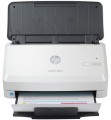Max. scan area
The maximum image size that the scanner can process at one time, both horizontally and vertically. You should pay attention to this parameter if you need the exact dimensions of the scanner's working area, down to a millimetre: although standard formats are used to designate these dimensions (see "Format"), in fact the dimensions may differ from them.
Colour depth (int.)
Under the internal colour depth is meant the number of shades of the image that the scanner itself can recognize; it should not be confused with external depth, which is the amount of hue transmitted to the computer (see below). Colour depth is expressed as the number of bits of information used to encode data about each colour. The total number of colour shades in this case is 2 to the power of n, where n is the colour depth. So, a 24-bit scanner recognizes 16.7 million colours — which is more than one and a half times more than the human eye, and quite enough for simple everyday tasks. In more advanced professional models, colour depth can reach 96 bits. Although the characteristics of the image transmitted to the computer are described by the external colour depth (which can be less than the internal colour depth), the internal depth, however, also affects its quality: other things being equal, a scanner with a higher internal depth provides more accurate colour reproduction.
Colour depth (ext.)
External colour depth characterizes the maximum possible number of colour shades in the image transmitted by the scanner to the computer. A depth of 24 bits is considered quite enough for non-professional tasks, in more advanced models this parameter can reach 96 bits. For details on colour depths and their relationship, see "Colour Depth (Int.)"
Shades of grey
The number of shades of grey that the scanner recognizes. You should pay attention to this parameter if you plan to actively work with complex black-and-white materials (for example, photographs) — the more shades, the higher the quality of the digitized image. To date, the average is considered to be 512 shades — this approximately corresponds to the capabilities of the human eye. Models with a lower indicator belong to the entry level, more advanced ones “understand” 1024 shades.
Mono scanning
The black and white scanning speed provided by the device. Usually, the maximum processing speed for an A4 sheet is indicated, i.e. speed at the lowest resolution. In fact, the speed is usually lower and depends on both the resolution and the size of the original material. The higher the scanning speed, the more convenient it is to work with the scanner; pay special attention to this parameter if you plan to work with numerous black and white images.
Colour scanning
Colour scanning speed provided by the device. In fact, it depends on the selected resolution, colour depth and original dimensions; the characteristics most often indicate the speed for an A4 sheet at the minimum resolution and colour depth, i.e. maximum possible speed. If you only need to scan one or more sheets from time to time, high speed is not too critical, but for working with a large amount of materials, you should look for fast models.
Operating cycle
The maximum number of pages that the scanner can process per day without overloading and the negative consequences associated with them. Most often indicated for A4 format. Even the most modest models of modern scanners have duty cycles measured in dozens of pages, which is quite enough for simple everyday tasks. Therefore, you should pay attention to this parameter if you have to scan numerous materials every day.
Data transfer
— Wi-Fi. A wireless interface primarily used to build local computer networks. In many respects it is similar to the LAN described below (in particular, it allows using the scanner as a network device), but it compares favorably due to the absence of a cable and the ability to work directly through walls. In addition, relatively recently, Wi-Fi modules have appeared with the ability to directly connect between devices — for example, to control a scanner from a tablet and transfer processed materials to the tablet directly, without creating a computer network. However
scanners with Wi-Fi are quite expensive.
—
USB. Universal interface for connecting various peripherals to a computer, including scanners. Today, it is the most common port of this type; at least one USB input is provided by the vast majority of PCs and laptops.
—
SCSI. Universal interface for connecting computer peripherals; has a good speed, however, it is much less common than its analogues, besides it is considered obsolete and is gradually being replaced by other standards.
—
IEEE-1394. Universal port, in many ways similar to USB (see above). Provides higher speed than the most common USB 2.0, but is much less common.
-LAN. Connector for connecting various devices to a local computer network. A scanne
...r with this interface can be connected as a network device and used with it by any computer on the network, which can be especially useful in offices.Power consumption
The maximum power consumed by the scanner during operation. The higher the power, the more energy the scanner consumes, but this only applies to the scanning process itself — in standby mode, power consumption is negligible. And even at the peak in most models, the power is so low that in fact this parameter has practically no effect on electricity bills and is more of an auxiliary value (for example, it is used to calculate the total power of devices connected to an uninterruptible power supply).

